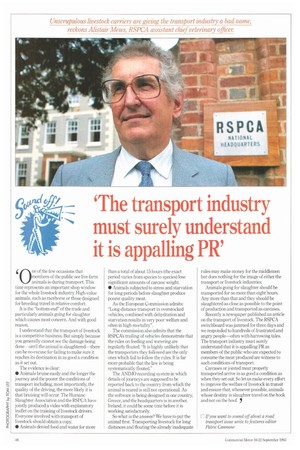The transport industry must surely understand
Page 48

If you've noticed an error in this article please click here to report it so we can fix it.
it is appalling PR'
4 ne of the few occasions that members of the public see live farm animals is during transport. This time represents an important shop window for the whole livestock industry High-value animals, such as racehorse or those designed for breeding travel in relative comfort.
It is the "bottom end" of the trade and particularly animals going for slaughter which causes most concern. And with good reason.
I understand that the transport of livestock is a competitive business. But simply because you generally cannot see the damage being done—until the animal is slaughtered—there can be no excuse for failing to make sure it reaches its destination in as good a condition as it set out.
The evidence is clear: • Animals bruise easily and the longer the journey and the poorer the conditions of transport including, most importantly, the quality of the driving, the more likely it is that bruising will occur. The Humane Slaughter Association and the RSPCA have jointly produced a video with explanatory leaflet on the training of livestock drivers. Everyone involved with transport of livestock should obtain a copy.
• Animals denied food and water for more than a total of about 15 hours (the exact period varies from species to species) lose significant amounts of carcase weight • Animals subjected to stress and starvation for long periods before slaughter produce poorer quality meat.
As the European Commission admits: "Long-distance transport in overstocked vehicles, combined with dehydration and starvation results in very poor welfare and often in high mortality".
The commission also admits that the RSPCA's trailing of vehicles demonstrate that the rules on feeding and watering are regularly flouted. "It is highly unlikely that the transporters they followed are the only ones which fail to follow the rules. It is far more probable that the law is being systematically flouted."
The ANIMO recording system in which details of journeys are supposed to be reported back to the country from which the animal is reared is still not operational. As the software is being designed in one country, Greece, and the headquarters is in another, Ireland, it could he some time before it is working satisfactorily.
So what is the answer? We have to put the animal first. Transporting livestock for long distances and flouting the already inadequate rules may make money for the middlemen but does nothing for the image of either the transport or livestock industries.
Animals going for slaughter should be transported for no more than eight hours. Any more than that and they should be slaughtered as close as possible to the point of production and transported as carcases.
Recently a newspaper published an article on the transport of livestock. The RSPCA switchboard was jammed for three days and we responded to hundreds of frustrated and angry people—often with harrowing tales. The transport industry must surely understand that it is appalling PR as members of the public who are expected to consume the meat produced are witness to such conditions of transport.
Carcases or jointed meat properly transported arrive in as good a condition as when they set out. So let us make every effort to improve the welfare of livestock in transit and ensure that, whenever possible, animals whose destiny is slaughter travel on the hook and not on the hoof.


























































































